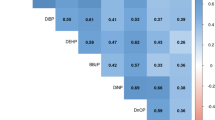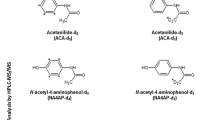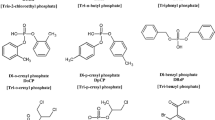Abstract
The object of this study was to investigate whether exposure of pipe-layers to thermal degradation products of diphenylmethane diisocyanate (MDI) could be assessed by analysing 4,4-methylenedianiline (MDA) in hydrolysed plasma and urine, and whether the genotype for N-acetylation affected these biomarker levels. Blood and urine samples were drawn from 30-pipe-layers who had been welding polyurethane (PUR) insulated pipes during the preceding 3 months. MDA in hydrolysed plasma and urine was determined with a gas chromatography-mass spectrometry technique, and genotype for N-acetylation was analysed with a polymerase chain reaction technique. MDA in plasma was detected in 18 of the 30 pipe-layers. Their plasma concentrations of MDA varied from 0.05 to 8.48 μg/1. There was a significant negative correlation between time since last welding of PUR-insulated pipes and P-MDA (r s = 0.50, P = 0.005). There was also a significant positive correlation between the estimated number of welded PUR-insulated pipes during the preceding 3 months and P-MDA (r s = 0.68, P = < 0.001). No significant association between genotype of N-acetylation and P-MDA was observed in a multiple regression analysis when adjustment was made for the estimated cumulative exposure to thermal degradation products of MDI. MDA in urine was detected in only four of the 30 pipe-layers. These four subjects had been welding PUR pipes on the same day as the sampling, or on the day before. The present results indicate the spot plasma samples analysed for MDA may give a rather good estimate of exposure to MDI during the preceding months. P-MDA, but not U-MDA, therefore seems to be a useful biomarker of long-term exposure to MDI. The individual N-acetylation capacity did not affect the plasma levels of MDA.
Similar content being viewed by others
References
Banks DE, Butcher BT, Salvaggio JE (1986) Isocyanate-induced respiratory disease. Ann Allergy 57:389–398
Blum M, Demierre A, Grant DM, Heim M, Meyer UA (1991) Molecular mechanisms of slow acetylation of drugs and carcinogens in humans. Proc Natl Acad Sci 88:5237–5241
Brunmark P (1994) Methods for assessment of exposure to aromatic amines/isocyanates by air monitoring and biomarkers. Thesis, Lund University (ISBN 91-628-1262-9)
Gustafson S, Proper JA, Bowie EJW, Sommer SS (1987) Parameters affecting the yield of DNA from human blood. Anal Biochem 165:294–299
Hagmar L, Nielsen J, Skerfving S (1987) Clinical features and epidemiology of occupational obstructive respiratory disease caused by small molecular weight organic chemicals. In: Epidemiology of allergic diseases. Monogr Allergy 21:42–58
Littorin M, Truedsson L, Welinder H, Skarping G, Martensson U, Sjöholm A (1994) Acute respiratory disorder, rhinoconjunctivitis, and fever derived from diphenylmethane diisocyanate. Scand J Work Environ Health 20:216–222
Renman L, Sangö C, Skarping G (1986) Determination of isocyanate and aromatic amine emissions from thermally degraded polyurethanes in foundries. Am Ind Hyg Assoc J 47:621–628
Rosenberg C, Savolainen H (1986) Determination in urine of diisocyanate derived amines from occupational exposure by gas chromatography-mass fragmentography. Analyst 11:1069–1071
Skarping G, Dalene M (1995) Determination of 4,4′-methylene diphenyldianiline (MDA) and identification of isomers in technical grade MDA in hydrolysed plasma and urine from workers exposed to methylene diphenyldiisocyanate. J Chromatogr 663:209–216
Skarping G, Renman L, Sangö C, Mathiosson L, Dalene M (1985) Capillary gas chromatographic methods for the determination of complex mixture of isocyanates and amines. J Chromatogr 346:191–204
Skarping G, Dalene M, Littorin M (1995) Determination of 4,4-methylenedianiline (MDA) in hydrolysed serum and urine from a worker exposed to thermal degradation products of MDI elastomers. Int Arch Occup Environ Health 66
Skarping G, Dalene M, Svensson B-G, Akesson B, Welinder H, Skerfving S (1996) Biomarkers of exposure, antibodies, and respiratory symptoms in workers heating polyurethane glue. Occup Environ Med (in press)
Vandenplas O, Malo J-L, Saetta M, Mapp CE, Fabbri LM (1993) Occupational asthma and extrinsic alveolitis due to isocyanates: current status and perspectives. Br J Ind Med 50:213–228
Vineis P, Caporaso N, Tannenbaum SR, Skipper PL, Gloggowski J, Bartsch H, Coda M, Talaska G, Kadlubar F (1990) Acetylation phenotype, carcinogen-hemoglobin adducts, and cigarette smoking. Cancer Res 50:3002–3004
Weber WW, Hein DW (1985) N-acetylation pharmacogenetics. Pharmacol Rev 37:25–79
Zeiss CR, Kanellakes TM, Bellone JD, Levitz D, Pruzansky JJ, Patterson R (1980) Immunoglobulin E-mediated asthma and hypersensitivity pneumonitis with precipitating antihapten antibodies due to diphenylmethane diisocyanate (MDI) exposure. J Allergy Clin Immunol 65:346–352
Author information
Authors and Affiliations
Rights and permissions
About this article
Cite this article
Dalene, M., Jakobsson, K., Rannug, A. et al. MDA in plasma as a biomarker of exposure to pyrolysed MDI-based polyurethane: correlations with estimated cumulative dose and genotype for N-acetylation. Int. Arch Occup Environ Heath 68, 165–169 (1996). https://doi.org/10.1007/BF00381626
Received:
Accepted:
Issue Date:
DOI: https://doi.org/10.1007/BF00381626




